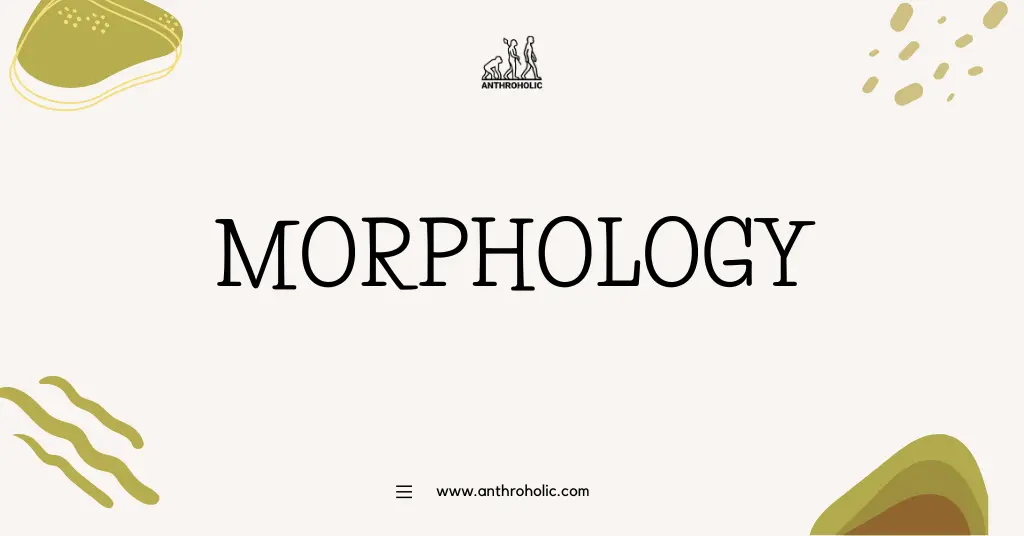AI Answer Evaluation Platform Live Now. Try Free Answer Evaluation Now
Morphology
Morphology, a crucial branch of linguistic anthropology, is the study of words’ internal structure and the ways they can be modified [1]. This discipline allows us to understand how meaning is constructed within a language, providing a rich understanding of cultural patterns and social structure.

Understanding Morphology
Morphology traces the complexity of linguistic forms and how they relate to meaning. It can be broken down into two primary components:
- Morphemes: The smallest linguistic unit with a meaning. They can be roots or affixes. For instance, ‘unhappiness’ can be divided into three morphemes: ‘un-‘, ‘happy’, and ‘-ness’ [2].
- Word Formation: The process of creating new words in a language. This can involve various mechanisms, such as derivation, compounding, and inflection [2].
Morphemes
Morphemes, often considered the building blocks of words, come in two forms:
- Free morphemes: Words that can stand alone and convey meaning. Examples include ‘book’, ‘run’, and ‘joy’.
- Bound morphemes: Elements that cannot stand alone as words. They must be attached to a free morpheme. Examples include ‘un-‘, ‘-ed’, and ‘-ing’.
| Morpheme Type | Examples |
|---|---|
| Free Morpheme | Book, Run, Joy |
| Bound Morpheme | Un-, -ed, -ing |
Word Formation
The creation of new words, or word formation, is a complex process:
- Derivation: This involves adding a morpheme to a base word to create a new word. For example, ‘happy’ (base word) + ‘-ness’ (suffix) = ‘happiness’.
- Compounding: This process combines two or more base words to create a new word. For instance, ‘black’ + ‘board’ = ‘blackboard’.
- Inflection: This process modifies a base word to express grammatical relationships between words in a sentence. For instance, ‘run’ + ‘-s’ = ‘runs’.
Applications of Morphology in Anthropological Research
Morphology provides a rich resource for anthropological research. By understanding the morphological structure of languages, researchers can draw conclusions about a society’s culture, worldview, and social dynamics.
Sociolinguistics
In sociolinguistics, the study of morphology provides insights into how social factors such as gender, age, social class, and ethnicity influence language use and variation.
- Social Differentiation: Morphological analysis can reveal how language is used to create and maintain social boundaries. For instance, some languages have distinct forms or styles of speech for different genders or social classes.
- Language Attitudes and Ideologies: Studying morphology helps to uncover attitudes and ideologies about language. For example, some societies may view certain morphological forms as prestigious or inferior.
Psycholinguistics
In psycholinguistics, morphology aids in understanding how language is processed and acquired.
- Language Processing: Researchers study morphological structure to understand how words are recognized and produced during communication. Morphemes play a vital role in word recognition and comprehension.
- Language Acquisition: Studying the acquisition of morphology provides insights into the stages of language learning, particularly in children. It also aids in developing effective teaching methods and materials for language learners.
Challenges in Morphological Study
Despite its importance, morphological study comes with its challenges:
- Complexity and Diversity: Languages vary greatly in their morphological complexity. This diversity can make it challenging to develop universal theories of morphology.
- Lack of Written Records: Many languages, particularly endangered ones, lack comprehensive written records, making morphological analysis difficult.
Importance of Morphology in Linguistic Anthropology
Linguistic anthropologists consider morphology as an essential tool to uncover cultural knowledge and social patterns [3].
- Language and Culture: Morphological analysis helps to unearth the cultural aspects embedded in a language. By studying the nuances of morphemes, we can better understand cultural nuances, such as honorifics in Japanese or gender agreement in Spanish.
- Language Change and Evolution: Morphology aids in tracing language evolution and change. By examining shifts in morphemes and word formation processes, we can gain insights into societal transformations and language contact phenomena.
- Language Acquisition: For language learners, understanding morphology can aid in vocabulary building and grammar comprehension.
Future Directions in Morphology
The field of morphology continues to evolve, adapting to new methodologies and technologies. Areas of future development include:
- Computational Morphology: With advancements in artificial intelligence and machine learning, there’s a growing interest in applying these technologies to study morphology, particularly in natural language processing and automated translation.
- Endangered Languages: As language extinction becomes an increasing concern, there is a push to document and analyze the morphology of endangered languages to preserve linguistic diversity.
Conclusion
Morphology, the cornerstone of linguistic anthropology, provides a deep and nuanced understanding of languages. Despite the challenges it presents, its potential applications in sociocultural research, language processing, and language learning make it a vital field of study.
References
[1] Haspelmath, M., & Sims, A. (2010). Understanding morphology. Routledge. http://dx.doi.org/10.4324/9780203776506
[2] Bauer, L. (2003). Introducing linguistic morphology. Georgetown University Press.
[3] Duranti, A. (2001). Linguistic anthropology: A reader. Wiley-Blackwell.




